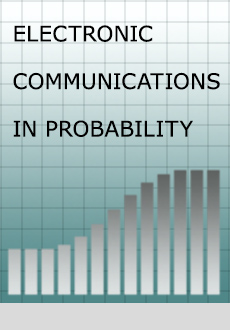Abstract
The binary branching Brownian motion in the boundary case is a particle system on the real line behaving as follows. It starts with a unique particle positioned at the origin at time 0. The particle moves according to a Brownian motion with drift and diffusion coefficient , until an independent exponential time of parameter 1. At that time, the particle dies giving birth to two children who then start independent copies of the same process from their birth place. It is well-known that in this system, the cloud of particles eventually drifts to ∞. The aim of this note is to provide a precise estimate for the total number of particles that were born on the negative half-line, investigating in particular the tail decay of this random variable.
Funding Statement
The authors were partially supported by ANR grant MALIN (ANR-16-CE93-0003) during the redaction of this article.
Acknowledgments
We are grateful to the anonymous referee for the relevant comments on the first version of this article.
Citation
Xinxin Chen. Bastien Mallein. "Total number of births on the negative half-line of the binary branching Brownian motion in the boundary case." Electron. Commun. Probab. 27 1 - 11, 2022. https://doi.org/10.1214/22-ECP449
Information





